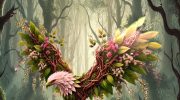 I have two urban fantasy novels published and numerous other stories sitting in my hard drive and desk drawer. One theme that runs through them all is the innate power of nature. The things that are ordinary in our real world, in the world of speculative fiction easily becomes something more. Whether it be a forest or a single tree, a river, lake, or the whole ocean, the sky or the earth; nature and its hidden depths are as much a part of our psyche and storytelling tradition as elves, faeries, wizards and witches. Writers open the doors and windows of perception tapping into imaginations ready to believe that a tree isn’t always just a tree sometimes it walks, talks, and goes to war, or that a lake truly has the power to strip away corruption. They have the ability to suspend belief in the ordinary and allow the extraordinary to shine through.
I have two urban fantasy novels published and numerous other stories sitting in my hard drive and desk drawer. One theme that runs through them all is the innate power of nature. The things that are ordinary in our real world, in the world of speculative fiction easily becomes something more. Whether it be a forest or a single tree, a river, lake, or the whole ocean, the sky or the earth; nature and its hidden depths are as much a part of our psyche and storytelling tradition as elves, faeries, wizards and witches. Writers open the doors and windows of perception tapping into imaginations ready to believe that a tree isn’t always just a tree sometimes it walks, talks, and goes to war, or that a lake truly has the power to strip away corruption. They have the ability to suspend belief in the ordinary and allow the extraordinary to shine through.
I come from a culture that, every day, seems to remove itself from its roots. Every day, we are drawn into a shallow, quick fix, “gimmegimme” world, which, if we think about it, we don’t really want. What we want is to be connected to each other and to nature. Who hasn’t walked through a forest and felt the presence of the trees – physically and through the senses. A novel I’m reading at the moment described it perfectly for me: “stretching like elastic and drawing it all in” (The Drago Tree by Isobel Blackthorn). This is how I feel when I walk under my favourite trees and reach out a hand to touch their bark or along my favourite bush track and stop to touch flowers and leaves. It’s what I sense when I stand at the edge of a cliff and feel breeze, sea mist, and sunshine soak into my skin. In one way or another, we all have this near spiritual connection with the natural realm that we can only feel when we escape our usual existence.
Presentation of magic and mysterious power where characters (and therefore readers) had not seen it before is a well used introduction to extraordinary worlds. Examples are present in so much fantasy literature, and no more so than in JRR Tolkien’s Ring series set in Middle Earth and Stephen Donaldson’s Chronicles of Thomas Covenant set in The Land. Each of these take what we know about the world around us and turn it into something extraordinary.
Tolkien’s Tom Bombadil from Lord of the Rings is a stand out example of a character that lives and breathes the “other”. The hobbits, even though they know stories of the Tree Herders and Elves, don’t really believe in the magic of nature until they are immersed in it; until they meet Tom and he opens their eyes to the extra-ordinary world around them. Tom and Goldberry are clearly more than they appear to Hobbits and Readers alike. They are the bridge between the reality of normal life and something more.
Stephan Donaldson takes this a step or two further. As soon as Thomas arrives in The Land, his senses are assailed from all directions by extra-ordinary life in a natural world where wood and stone have Power that can be mastered and used for the benefit of the community, where metal (white gold in particular) has the Power to cause all sorts of havoc, and water brims with energy. As in Tolkien’s Middle Earth, the power/energy of nature in Donaldson’s fantasy world is not latent, waiting to be manipulated, it also has the ability to transform, grow, create, and be corrupted.
A specific example is the first time that Thomas needs healing. For a leper, minor scrapes carry the threat of gangrene. Lena brings him Hurtloam and Thomas responds with,”I need soap not more dirt’. But Thomas is now in The Land where ordinary seeming dirt can be a miracle cure and his hurts are are healed…
Countless other fantasy stories use nature to send messages, be “signs” of change, stake claims, and allow passage for brave travellers. The fantasy genre, in general, romanticises our yearnings for nature. We think of nature and culture as static ideas that are mutually exclusive but rather, they are spheres that interact.
Fantasy writing, through this romanticised and idealised vision of life, allows readers to recognise these interactions and imagine that their ordinary world contains magic and that the ordinary and mundane that surrounds them can become extra-ordinary just because they believe.
Horror writers take advantage of the human instinct to see nature as an adversary and as sheltering unknown fears through a romanticised vision of death. We’ve grown up on stories and fables like Little Red Riding Hood and The Gingerbread House where in the “deep dark woods” danger lurks and lives are threatened by hungry wolves and witches. Here readers are not romanticised but confronted with fear within and without. In a safe environment (after all, we can always put the book down), we can experience the thrill of danger that may scare the pants off us, but won’t cause real pain. Of course, the “lurkiness” of such stories can be a problem. How many of you can walk through parks and under trees in the darkness of late night without feeling the thread of fear tingle across your skin or in the corners of your imagination?
 In The Ouroboros Key I used nature as symbolism: salmon as wisdom, a shimmering moon as a sign of change to come, ravens as messengers, and the snake or serpent as creator. In A Single Light, which is more “horror” orientated, I use a natural setting: the Australian bush, sandy tracks, the sound of cicadas, heat, and fire, to aid, to hinder, and to bring characters and readers from a known place of relative safety to a supernatural battle zone. Turning the rather ordinary bushland of the Royal National Park into such a danger zone was one of my main goals with this story.
In The Ouroboros Key I used nature as symbolism: salmon as wisdom, a shimmering moon as a sign of change to come, ravens as messengers, and the snake or serpent as creator. In A Single Light, which is more “horror” orientated, I use a natural setting: the Australian bush, sandy tracks, the sound of cicadas, heat, and fire, to aid, to hinder, and to bring characters and readers from a known place of relative safety to a supernatural battle zone. Turning the rather ordinary bushland of the Royal National Park into such a danger zone was one of my main goals with this story.
Once the book is put down or finished, the mundane world once again takes over. We put aside visions of better (or scarier) places and turn our focus back to getting to work or home, putting dinner in the oven or whatever it is that makes life routine. For the avid fantasy reader though, the world will never again be only ordinary.
Bio:
Patricia Leslie is a Sydney author with a passion for combining history, fantasy, and action into stories that nudge at the boundaries of reality. Her debut novel, The Ouroboros Key, was released in 2014 and A Single Light in 2016 through indie press, Odyssey Books.
Follow Patricia on Facebook and Twitter, and visit her webpage: www.patricialeslie.net





Well said! I love stories that bring a place (real or imagined) to life just as you describe.
I couldn’t agree more – I also have always thought the true magic in Lord of the Rings was Tom Bombadil. I find some of the same feeling in Ursula Vernon’s stories. Now I’ll have to check out yours!